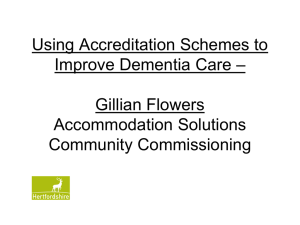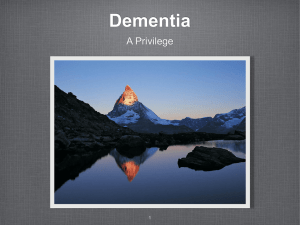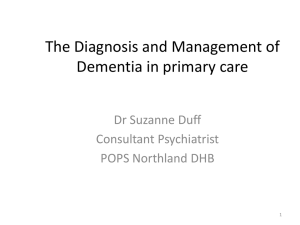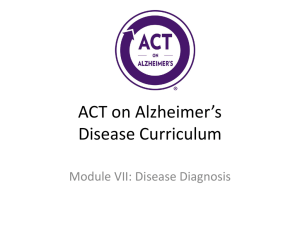L. Esralew`s Presentation
advertisement
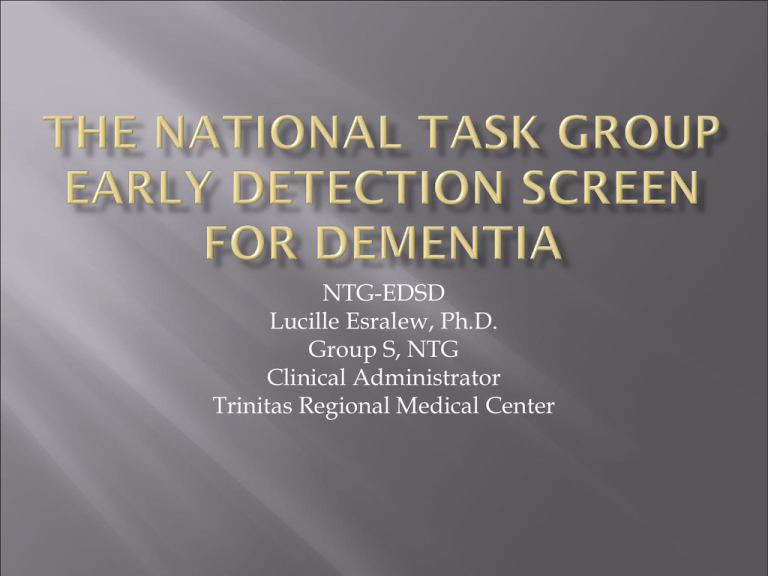
NTG-EDSD Lucille Esralew, Ph.D. Group S, NTG Clinical Administrator Trinitas Regional Medical Center Unexpected memory problems Getting lost or misdirected Problems with gait or walking New seizures Confusion in familiar situations Changes in personality Difficulty performing usual tasks at home or at work Reduced work performance Difficulties with recent memory and new learning Changes in communication skills including impoverishment in language use compared with baseline Emotional lability, heightened irritability, apathy, “coarsened” social behavior Neuropathological changes are likely to precede clinical signs of probable Alzheimer’s dementia by more than a decade If dementia can be identified earlier, there is the potential to proactively address signs and symptoms. Interventions, services or supports may be more effective if offered prior to significant cognitive and/or functional change. Greater opportunity to impact quality of life and quality of care Early identification of signs and symptoms of cognitive and functional decline associated with dementia is an important first step in managing the course of the disease and providing quality care Family and professional caregivers should work with the consumer’s health care provider to share information about observed changes NTG is promoting a screening tool the National Task Group Early Detection Screen for Dementia (NTG-EDSD) to substantiate changes in adaptive skills, behavior and cognition An early diagnosis may slow the progression of symptoms; early treatment can help maintain a person’s current level of functioning. An early and accurate diagnosis can also help to identify reversible conditions that may mimic dementia such as depression, medication side effects, substance abuse, vitamin deficiencies, dehydration, bladder infections or thyroid problems. An initial assessment can avoid the trauma of a diagnosis of dementia where it does not exist. It also prevents unnecessary and possibly harmful treatment resulting from misdiagnosis Identifying the cause of decline can lead to proper, targeted care and affords a greater chance of benefiting from existing treatments Early diagnosis can help ease the anxiety that may accompany unexplainable changes in behavior Educating persons with dementia and their caregivers gives them time for advanced care planning The quality of life for both the person with dementia and the family can be maximized Earlier treatment may delay the progression of symptoms Dearth of standardized assessments for persons with IDD that confirm/disconfirm significant changes in cognition and adaptive functioning Debate about what constitutes significant change among persons with pre-existing memory and other cognitive impairments Diagnostic overshadowing…everything is attributed to IDD Pre-existing cognitive impairment, behavioral disorders and poor emotional control may complicate recognizing the early signs of dementia Early cognitive and functional changes may be subtle or intermittent Pre-existing level of intellectual ability, sensory impairment, and health status may all impact upon cognitive and functional status Proceed with caution Probable AD What about other types of dementia? May take time to confirm/disconfirm a diagnosis What is the value of a diagnosis in terms of services, treatment and supports MCI and the progression to dementia Raise awareness of symptoms Request/provide assessments Monitor health and medications Keep a record of changes Plan ahead for eventual decline Design residences that are “dementia capable” Encourage state and local officials to budget for community care resources for those adults affected by dementia and their caregivers Support local Alzheimer’s/dementia events The information collected from the NTGEDSD can be shared with the consumer’s primary care physician and then a determination of need for further testing or a referral to a specialist can be made at that time. Need to equip family and professional caregivers with a tool to capture information about changes in cognition and function Provide caregivers with a format to share important information with the consumer’s health care practitioner Tool trains caregivers to be better observers and reporters of relevant signs and symptoms of change Clinicians report that individuals are not brought to attention until well advanced in the dementing process Need for an administrative tool that will help link individuals who exhibit change to relevant health care options Cognitive and functional status are not usually included in annual health screenings For those eligible, the NTG-EDSD could be used as part of the Annual Wellness Visit Tool based on the DSQIID (Deb, 2007) Unlike the original instrument, the NTG does not purport that the NTG-EDSD should be used for the purpose of diagnosis or assessment Items from the Longitudinal Health Inventory have been added to provide information about chronic health conditions The NTG-EDSD can be downloaded from the AADMD website Early Detection Screen for Dementia an instrument adapted from the Dementia Screening Questionnaire for Individuals with Intellectual Disabilities ( Deb et al., 2007) and the Dementia Screening Tool (adapted by Philadelphia Coordinated Health Care Group from the DSQIID, 2010) Down Syndrome begin age 40 then annually, non-DS begin when changes are noted Piloted in 8 sites during the Fall of 2012 http://aadmd.org/ntg/screening Lucy Esralew lesralew@trinitas.org Special thanks to Matthew Janicki, Ph.D. for giving permission for the use of his slides






